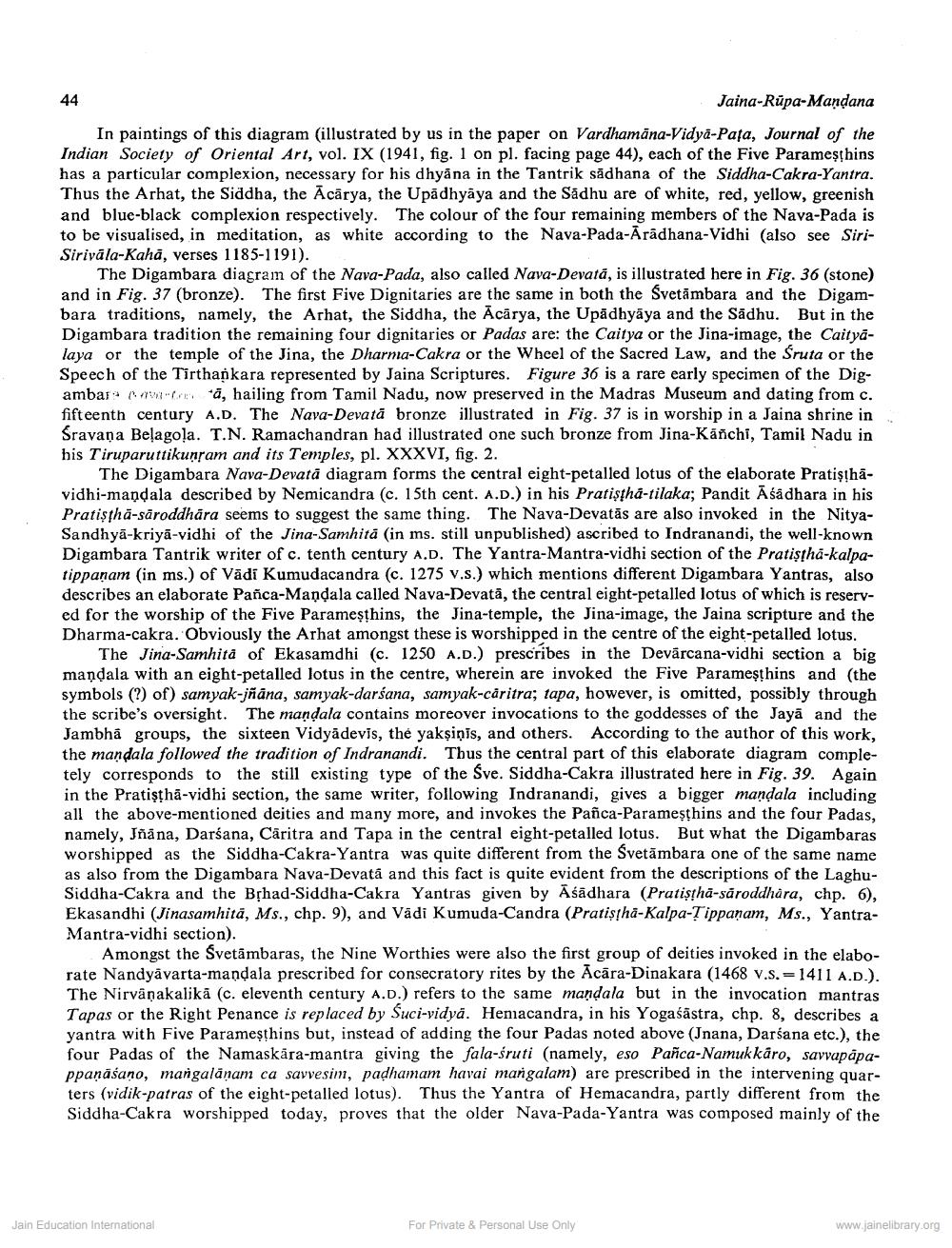________________
44
Jaina-Rupa-Mandana In paintings of this diagram (illustrated by us in the paper on Vardhamāna-Vidyā-Pata, Journal of the Indian Society of Oriental Art, vol. IX (1941, fig. 1 on pl. facing page 44), each of the Five Parameşthins has a particular complexion, necessary for his dhyāna in the Tantrik sādhana of the Siddha-Cakra-Yantra. Thus the Arhat, the Siddha, the Acārya, the Upadhyaya and the Sadhu are of white, red, yellow, greenish and blue-black complexion respectively. The colour of the four remaining members of the Nava-Pada is to be visualised, in meditation, as white according to the Nava-Pada-Aradhana-Vidhi (also see SiriSirivāla-Kahā, verses 1185-1191).
The Digambara diagram of the Nava-Pada, also called Nava-Devatā, is illustrated here in Fig. 36 (stone) and in Fig. 37 (bronze). The first Five Dignitaries are the same in both the Svetāmbara and the Digambara traditions, namely, the Arhat, the Siddha, the Acārya, the Upadhyāya and the Sadhu. But in the Digambara tradition the remaining four dignitaries or Padas are: the Caitya or the Jina-image, the Caityalaya or the temple of the Jina, the Dharma-Cakra or the Wheel of the Sacred Law, and the Sruta or the Speech of the Tirthankara represented by Jaina Scriptures. Figure 36 is a rare early specimen of the Digambar l ā, hailing from Tamil Nadu, now preserved in the Madras Museum and dating from c. fifteenth century A.D. The Nava-Devatā bronze illustrated in Fig. 37 is in worship in a Jaina shrine in Sravana Belagola. T.N. Ramachandran had illustrated one such bronze from Jina-Kāñchi, Tamil Nadu in his Tiruparuttikunram and its Temples, pl. XXXVI, fig. 2.
The Digambara Nava-Devata diagram forms the central eight-petalled lotus of the elaborate Pratişthāvidhi-mandala described by Nemicandra (c. 15th cent. A.D.) in his Pratisthå-tilaka; Pandit Āśadhara in his Pratişthă-săroddhāra seems to suggest the same thing. The Nava-Devatās are also invoked in the NityaSandhyā-kriyā-vidhi of the Jina-Samhita (in ms. still unpublished) ascribed to Indranandi, the well-known Digambara Tantrik writer of c. tenth century A.D. The Yantra-Mantra-vidhi section of the Pratiştha-kalpatippanam (in ms.) of Vādi Kumudacandra (c. 1275 v.s.) which mentions different Digambara Yantras, also describes an elaborate Panca-Mandala called Nava-Devatā, the central eight-petalled lotus of which is reserved for the worship of the Five Parameşthins, the Jina-temple, the Jina-image, the Jaina scripture and the Dharma-cakra. Obviously the Arhat amongst these is worshipped in the centre of the eight-petalled lotus.
The Jina-Samhita of Ekasamdhi (c. 1250 A.D.) prescribes in the Devārcana-vidhi section a big mandala with an eight-petalled lotus in the centre, wherein are invoked the Five Parameșthins and (the symbols (?) of) samyak-jñāna, samyak-darśana, samyak-caritra; tapa, however, is omitted, possibly through the scribe's oversight. The mandala contains moreover invocations to the goddesses of the Jayā and the Jambhá groups, the sixteen Vidyādevis, the yakşiņis, and others. According to the author of this work, the mandala followed the tradition of Indranandi. Thus the central part of this elaborate diagram completely corresponds to the still existing type of the Sve. Siddha-Cakra illustrated here in Fig. 39. Again in the Pratişthā-vidhi section, the same writer, following Indranandi, gives a bigger mandala including all the above-mentioned deities and many more, and invokes the Panca-Paramesthins and the four Padas, namely, Jñana, Darśana, Caritra and Tapa in the central eight-petalled lotus. But what the Digambaras worshipped as the Siddha-Cakra-Yantra was quite different from the Svetāmbara one of the same name as also from the Digambara Nava-Devata and this fact is quite evident from the descriptions of the LaghuSiddha-Cakra and the Bhad-Siddha-Cakra Yantras given by Aśādhara (Pratişthă-săroddhara, chp. 6), Ekasandhi (Jinasamhitä, Ms., chp. 9), and Vädi Kumuda-Candra (Pratistha-Kalpa-Tippanam, Ms., YantraMantra-vidhi section).
Amongst the Svetāmbaras, the Nine Worthies were also the first group of deities invoked in the elaborate Nandyāvarta-mandala prescribed for consecratory rites by the Acāra-Dinakara (1468 v.s.= 1411 A.D.). The Nirvanakalikā (c. eleventh century A.D.) refers to the same mandala but in the invocation mantras Tapas or the Right Penance is replaced by Suci-vidya. Henacandra, in his Yogaśāstra, chp. 8, describes a yantra with Five Parameșthins but, instead of adding the four Padas noted above (Jnana, Darśana etc.), the four Padas of the Namaskara-mantra giving the fala-śruti (namely, eso Panca-Namukkaro, savvapapappanāśano, mangalānam ca savvesim, padhamam havai mangalam) are prescribed in the intervening quarters (vidik-patras of the eight-petalled lotus). Thus the Yantra of Hemacandra, partly different from the Siddha-Cakra worshipped today, proves that the older Nava-Pada-Yantra was composed mainly of the
Jain Education International
For Private & Personal Use Only
www.jainelibrary.org




